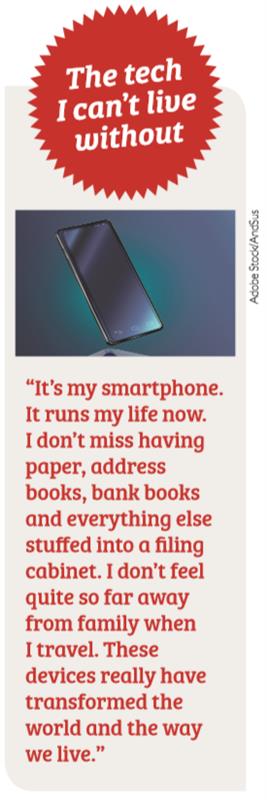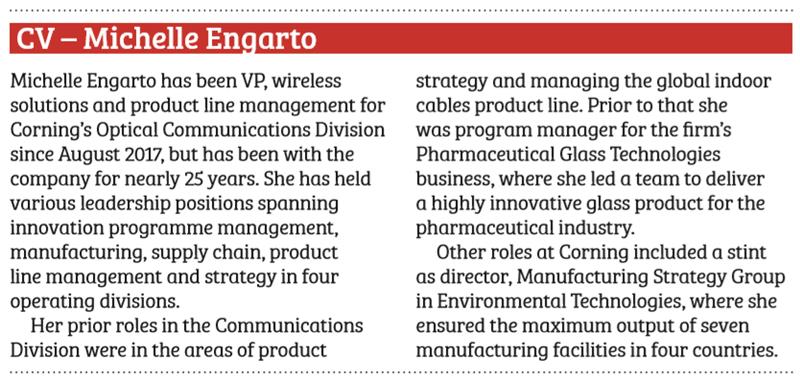Michelle Engarto, VP, wireless product management at Corning Optical Communications, is responsible for its wireless portfolio, which includes small cells, DAS and hybrid wireless solutions. Corning had an established presence in the DAS market, but added a new string to its bow when it acquired pioneering small cell provider SpiderCloud in 2017.
There are plenty of enterprises still crying out for 3G/4G indoor coverage, and Engarto is keen to capitalise on this need using the established portfolio of solutions. However, looking to the near future, she says: “Our task now is to get enterprises ready for 5G and all the applications we expect to come with it.
“First, we need to provide an upgrade path to 5G for our 4G small cells and DAS platform, and second, we need to make sure we have solutions that are attractive for enterprises. At present, providing indoor coverage for middle-sized buildings is not an attractive proposition for mobile network operators (MNOs) to solve, but they are too small for enterprises to solve themselves with a full-blown DAS solution.”
She adds: “We saw a growing need there and we wanted to make sure we had a solution for these sorts of buildings and enterprises as well. We don’t mind who is buying our solutions, we just want those solutions to solve the coverage and capacity problems for any size of enterprise or building.”
Corning announced a collaboration with Qualcomm Technologies in February to combine its small cell expertise and Qualcomm’s leadership in 5G and mmWave technology. Corning will use Qualcomm’s FSM100xx 5G RAN platform to develop 5G NSA mmWave infrastructure systems for enterprises and public venues such as offices, university campuses, hospitals, hotels and shopping centres.
Corning is bringing the “secret sauce” of a decade of learning about engineering indoor coverage solutions and adding it to the Qualcomm chipset. It is therefore using a Corning product based on Qualcomm technology, which is completely differentiated from what anyone else is doing in the small cell space.
What it is adding is “significant engineering brainpower” – all the lessons it has learnt from a decade of providing indoor coverage. Corning engineers are looking at many significant factors relating to indoor performance: how RF behaves with walls and ceilings; how the signal bounces; how to deal with non-line of sight; and so on.
“We need to provide elegant, low-cost, easy to install and manage, scalable 5G solutions,” says Engarto, who adds that the industry can expect to see Corning 5G products launching commercially later this year.
Some have questioned whether 5G mmWave spectrum is going to work well indoors. But Engarto points out that people also questioned its use outdoors and observes that there are already outdoor mmWave small cells deployed and working well in the USA.
Are indoor 5G mmWave small cells needed yet? “There absolutely is demand for the product,” says Engarto firmly. “We are talking to our customers and they are showing that there is a real demand for this product in the indoor space.”
As small cell manufacturers have found, it has not been easy to bring together all the necessary parties needed to implement indoor cellular networks. Real estate developers, building owners and tenants, the small cell manufacturers and the mobile operators all need to collaborate efficiently in order to deliver indoor coverage solutions.
Engarto agrees that there has been a lot of dragging of feet to get 4G solutions into buildings. “Building owners need to think about deploying the right infrastructure in the building,” she says. “They need more fibre and more power to deliver more bandwidth and probably ultra-reliable, low-latency communications (URLLC) too.”

But 5G mmWave will bring different challenges and require different architectures from 4G. “We have to leverage the platform we already have and the two technologies must work together seamlessly, so we have work to do there. It is a challenge, but we know how to do that,” says Engarto.
She adds that one challenge for enterprises looking to implement 5G coverage is that repeaters are not as effective as in the past. “Transmitting the 5G signal into the building from outside using mmWave is not going to work well. So, you have to consider doing something inside the building, and that something is going to be different from 3G/4G indoor architectures.”
One difference between 4G and 5G mmWave is that the latter does not propagate very far and is less able to penetrate walls. This calls for a diff erent RF design. “We can utilise new 5G features like beamforming to make 5G eff ective. With beamforming you split the signal path into several beams to form a path in the direction of the intended users and track and find the best path for those devices,” explains Engarto.
SpiderCloud developed its 4G E-RAN small cells so that they could be implemented using existing Ethernet LAN (they can share the enterprise LAN via private VLAN), which provided a big deployment advantage as it is both fast and economical. No need to pull new cabling.
But as Engarto explains, this will not be possible with 5G small cells as they will need more power to run the more demanding applications that 5G will support and they need the increase in capacity that fibre can bring.
“The new 5G mmWave small cells will run on composite cable where there are copper strands inside the fi bre cable. This means you can deliver both power and bandwidth to the edge nodes and you only need one cable pull,” says Engarto.
The mmWave small cells will use the high 5G spectrum bands, but Corning will also be launching sub-6GHz low and mid 5G band products. “These deliver a really nice performance, but they have less bandwidth capacity than the mmWave bands, which have loads of capacity available,” notes Engarto.
“Not everyone will need an indoor coverage solution which is that powerful,” acknowledges Engarto. “4G is very powerful anyway. But customers will need 5G for very high bandwidth applications like AI, massive machine-to-machine solutions, for uploading and downloading huge amounts of data, or for when there are very dense concentrations of many users like in a stadium.”
One of the keys to delivering indoor coverage solutions, besides getting all the necessary parties aligned, is to ensure the product is easy to install. “We have spent a lot of time working on how to make implementation easy enough for someone who is not an RF expert or indoor coverage expert,” says Engarto.
“Self-organising networks (SON) is the trade secret. Where we really compete with others in this space is in terms of what our software enables and how we make the solution simple to install and manage.”
Corning has partners that sell its solutions through enterprises and then help it install and commission the gear. “It has not been an insignificant effort to get this channel in place,” observes Engarto. “In fact, there has been a tremendous amount of effort on our part to ensure we have enough quality partners to enable us to scale up.”
Corning has a national approval process with three of the four main US operators. When a customer or channel partner needs an operator to approve the installation and connection into the macro network, Corning can accelerate the approval process.

Corning also offers a hybrid solution using DAS and small cells, which it calls DAS Headend. Small cell radio nodes are used as the signal source to feed the DAS around the building. Up to eight small cells can be fitted in a rack in place of a macro cellular base station.
The capital expense reduction of using small cells rather than a macro base station is “fairly significant”, but it is the electricity consumption that really drops – by 30 per cent. Power supply is one of the big operational costs of DAS.
Engarto says: “When you look at all the innovation Corning does, and don’t forget, we invented fibre 50 years ago, we’ve got indoor and outdoor copper and fibre cables, lots of connector solutions, we have got an SD-LRAN off ering and we have the suite of wireless solutions.
“We are in a very solid position to bring connectivity to buildings. I think there is enough happening in the ecosystem now to drive real demand for indoor coverage. We have been working at this for a long time."



